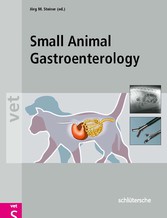Suchen und Finden
2 Clinical Evaluation of Dogs and Cats with Specific Clinical Signs (p. 115)
2.1 Clinical Evaluation of Patients with Acute Signs of Gastrointestinal Disease
Keith P. Richter
2.1.1 Introduction
Acute gastrointestinal disease is a common reason for dogs and cats to be presented for veterinary care. Clinical signs can range from mild and self-limiting to severe and life-threatening. These signs can be divided into regurgitation, vomiting, diarrhea, or any combination there of. The initial clinical evaluation must take into account the severity of the animal’s condition. This will help determine the extent of the diagnostic evaluation and guide initial treatment strategies. In cases with mild clinical signs, the diagnostic evaluation may be limited, and require only outpatient symptomatic care. In animals with severe clinical signs, a more thorough evaluation and inpatient care may be necessary. Complications of vomiting and diarrhea include dehydration, electrolyte imbalances, acid-base disturbances, aspiration pneumonia, and malnutrition and /or protein depletion. In most cases, it is helpful to establish a definitive diagnosis, but this is not always necessary or possible.
2.1.2 Diagnostic evaluation of vomiting
2.1.2.1 Vomiting versus regurgitation
It is critical to distinguish between vomiting, regurgitation, and gastroesophageal reflux when obtaining the initial history, because the diagnostic and treatment approaches are vastly different. Vomiting is a reflex act that includes prodromal signs followed by active abdominal contractions. The prodromal signs may include behavioral changes, salivation, and repeated swallowing attempts. It must be emphasized that these signs are variable. In contrast, regurgitation is a passive act that is often spontaneous or associated with changes in body position. There are no prodromal signs and there are no repetitive abdominal contractions. Regurgitation is typically associated with disorders of the esophagus (see 3.3). The best way to differentiate these two clinical signs is to imitate the two acts for the client, emphasizing the repetitive abdominal contractions seen in the vomiting patient as the most reliable distinguishing feature. The timing of the event with respect to eating, the volume of material brought up, or the character of the contents (unless it contains bile, suggestive of vomiting) do not reliably distinguish vomiting from regurgitation.
2.1.2.2 The vomiting reflex
The vomiting reflex begins with afferent receptors located in visceral organs (including GI tract, pancreas, heart, liver, genitourinary tract, and peritoneum) and the pharynx.1 The afferent impulses travel through the vagus and sympathetic nerves to the vomiting center located in the medulla. Vomiting can also be initiated by stimulation of the chemoreceptor trigger zone (CRTZ) located in the area postrema of the medulla.1 The CRTZ is sensitive to blood-borne substances. The vomiting reflex can also be initiated by input from the cerebral cortex (rare in animals vs. human beings) and from the vestibular apparatus (i. e., motion sickness). Thus, vomiting can be initiated through a "humoral" pathway, caused by blood-borne substances stimulating the CRTZ, or a "neural" pathway, caused by stimulation of the vomiting center from vagosympathetic, CRTZ, vestibular, or cerebral neurons.
Alle Preise verstehen sich inklusive der gesetzlichen MwSt.



















